Windows 98 USB Mass Storage Driver: Download & Install Guide [2025]
Windows 98, although outdated, is still used in some specialized environments where legacy software needs to run. However, one of the major challenges for those using Windows 98 is compatibility with modern USB storage devices. Fortunately, it’s still possible to get these devices working with the right drivers.
This guide will walk you through the steps to install a generic USB mass storage driver and also provide some useful tips for troubleshooting common issues with USB devices on Windows 98.
Why Windows 98 Struggles with USB Mass Storage Devices
Windows 98SE lacks a built-in generic mass storage driver for USB devices, which makes it difficult to use modern USB flash drives and other USB storage devices. Unlike newer versions of Windows, which automatically recognize these devices, Windows 98 requires specific drivers to detect and work with them. As a result, many USB devices, including flash drives and external hard drives, might not be detected by the system.
How to Install a Generic USB Mass Storage Driver
Step 1: Download the Generic Driver
First, download the Windows 98SE Generic USB Mass Storage Device Driver to your desktop.
Step 2: Remove Old USB Drivers
Go to Device Manager (right-click My Computer ? Properties ? Device Manager) and remove any existing drivers for USB flash drives or USB controllers under Universal Serial Bus controllers. Uninstall any Unknown/Other devices with no drivers.
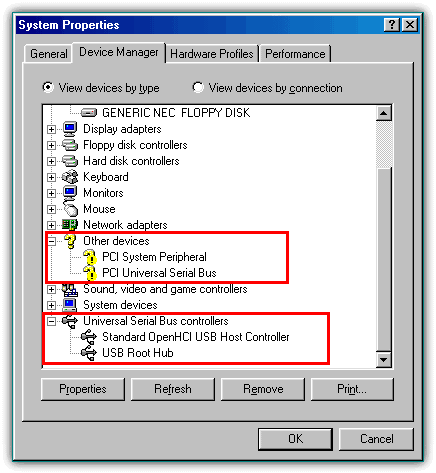
Step 3: Install the Driver
Run the nusb36e.exe driver installer. Once completed, reboot your computer.
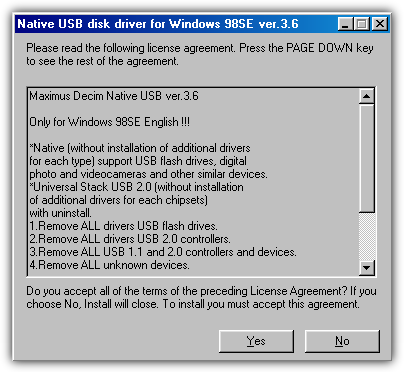
Step 4: Reboot and Connect Your USB Device
After rebooting, your system should detect new USB controllers. When prompted, insert your Windows 98 install CD for required files. If the system requests a reboot again, follow the instructions.
Step 5: Insert Your USB Storage Device
Insert your USB flash drive or storage device. If formatted with FAT/FAT32, Windows 98 will recognize it and assign a drive letter.
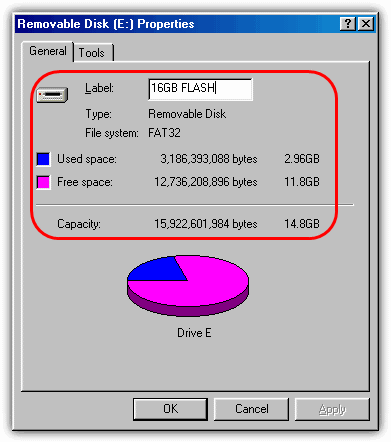
Step 6: Check Device Manager
If everything went well, the flash drive or device should be visible in My Computer.
Troubleshooting Tips
If your USB device still isn’t recognized, try these additional troubleshooting steps:
- Check BIOS Settings: Ensure that USB support is enabled in your BIOS.
- Try Another Computer: Test your USB device on a different computer to rule out device issues.
- Use a Different USB Port: Some USB ports may not provide enough power for the device. Try switching ports.
How to Use Additional Tools for Driver Updates
If the generic driver doesn’t work, you can try additional tools to help find compatible drivers for your system.
DriverFix Software
DriverFix is a utility tool that can help you find missing or outdated drivers. With over 500,000 drivers on their platform, it’s a great way to quickly find USB mass storage drivers for your Windows 98 device.
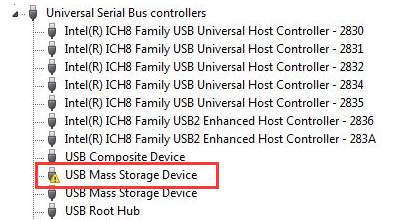
- Download and install DriverFix: After installation, run the tool to allow it to analyze your system and detect missing USB storage drivers.
- Scan and install drivers: After scanning, the application will list any missing drivers, and you can install them manually.
Snappy Driver Installer
Another useful tool is Snappy Driver Installer, which can help find drivers for many types of hardware, including USB storage devices. This is particularly useful if DriverFix doesn’t offer the driver you need.
Driver Booster
Driver Booster is another driver updater that supports a wide variety of devices. It’s another great tool for keeping your system up-to-date.
Example: Kingston DataTraveler Flash Drive on Windows 98
To illustrate this process, consider a company that purchased a Kingston DataTraveler USB flash drive for backups on a computer running Windows 98. The system couldn’t be upgraded due to legacy software requirements, so the decision was made to stick with Windows 98 and source compatible hardware. However, after encountering driver issues, we used the steps outlined above to get the USB device working.
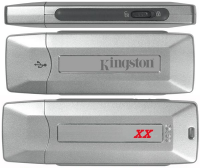
Conclusion
Windows 98 may be outdated, but it is still possible to use modern USB devices with the correct drivers. By following these steps and using tools like DriverFix, Snappy Driver Installer, or Driver Booster, you can extend the life of your legacy system. If all else fails, consider using a virtual machine to run Windows 98 or exploring an upgrade to Windows XP for better compatibility and security.
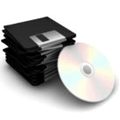
you’re the man now dog
It works like a dream! When I rebooted Windows didn’t automatically see it, went into Device Manager and clicked Refresh and Windows picked it up that fast! Close all Windows on the desktop and open My Computer, it will be listed as Removable Disk! Then you’re all set, I didn’t think it were possible to see your basic DataTraveler G3 mass storage device under Windows 98SE but miracle on miracle it works great on my IBM ThinkPad 770X!
At first my USB storage device did not work, but after i did a reinstal the driver
as mass storage device, W98SE (dutch version)W98SE worked fine with my usb stick.
(device manager usb, properties) Verry happy now
WOnderful!
But —
I have W98, not W98SE.
Assuming there is a similar solution for W98, will it work both for flash drives AND external hard drives (Portable Hard Drives)? I have several, of 250GB, 750GB, and 3TB capacities.
And, assuming there is such a driver — either for flash drives or PHDs, or both — where can I get it?
Thank you so much!
This worked perfectly on my “new” w98 build!
Amazing program and works great. I can finally use a flash drive instead of burning cd’s to get windows 98 better.
Brilliant!
Excellent,
Worked a dream, Win98 now reads Kingston USB stick, so I can now recover all my old treasured Win98 stuff…
Magnus.
I was getting extremely frustrated after days of trying to find the proper USB drivers for my Gateway Armada e500 laptop running a fresh install of Windows 98 SE until i ran across this site purely by accident. I figured I would give this a try because I was starting to get desperate at this point. I had already gone through over a dozen CD-R disks in an attempt to find the right drivers and had one more left. Took a chance and burned this software to my very last CD and installed it. IT WORKED!! It read and installed my 16gb flash drive immediately. No more burning disks to copy files to my laptop. THANK YOU!!!
I had long known this was possible (I think Phils Computer Lab has something like this linked) but this was a well-written, easy to understand process. This saved me from the necessity of removing the hard disk from my Armada 1750 and copying games to it though an intermediary “multi-media” PC (a P4 with IDE (40 and 44 pin), SATA, SCSI (1 and 2) Zip100, and a few other proprietary 90s stuff). Thank you, it worked the first time, now I can copy large files over without the need for taking stuff apart.
:D
fantastic !! thanks very much. it worked for my Toshiba satellite 320 with dual dos and win 98. it even reads sd cards with the appropiate interface. all in fat32 ofcourse. this configuration is ideal for flashing old motorola radio equipment both with DOS and windows CPS
It did not work for me. I get a message that it only works from 98 SE 4.10.0.2222A – but I have 4.10.2222 – and I haven’t been able to find an upgrade from 4.10.2222 to 4.10.0.2222A
This worked for me! Thank you very much for sharing!
YESSS!!! thankyou! I was getting sick of copying files over zip disks to my windows 98 machine.
Used the Nusb36e on an old Windows98 machine. Rebooted and presto- it immediately recognized an older 32gb USB stick. Great! Thanks!
Worked great for me. Thank you!!
When my win 98 couldn’t read a usb stick the operating system asked for specific files. I simply searched the files and dragged them onto a floppy disk. The files are there in win 98, the computer simply doesn’t know where to look for them. Now when I put a new usb drive in I simply put the floppy in and win 98 picks up the files it requires. I have several old computers with win 98. It works on them all.
Does not work with the following USB controllers:
Intel 82371AB/EB USB 1.0 Universial Host Controller
OPTi 82C861 (Firelink) PCI to USB Open Host Controller (USB 1.1)
Thank you very much. I was able to use the driver in our old Win 98 computer connected to a scientific instrument to retrieve files using the usb port. Our old CD burning program was not working so I decided to use the usb in desperation. The usb port is not working in our Win 98 computer in the first place so I searched the internet for a driver. After the download I followed the instructions and it works great. This is so helpful and I am so grateful to you sir!
This was exactly what I was looking for. Thank you for posting this information. I use an old Toshiba laptop for retro gaming. I wanted to connect my external 500 Mb HDD to the one USB port on this laptop, I was doubtful if this would work, but as soon as I installed this driver and rebooted, my external was detected as a mass storage device and works great.
Thank you! With this information I was able to finally use a PCMCIA USB adaptor with my old Dell Latitude XPi CD Windows 98SE. I had been going around in circles beforehand. I need to retain an older PC in order to be able to program some of the older 2-way mobile and portable radio equipment which is still soldiering on.
Thanks, I tried several times using the instructions but it didn’t seem to auto load my kingston datatraveler flash drive. However, in the device manager it showed up as ? But then when clicking and selecting update driver… Win98se found and loaded the general USB mass storage driver for it. Nice…
I can see the files as loaded under E: drive now. Very nice to have something you need work when everyone is telling you “IT WILL NOT WORK!”
It works!!! :)
It just simply works!!! :)
Isn’t that how things are supposed to be?
It didn’t work with my camera, but that’s no problem. I just pop the chip and plug it into a card reader and it works! A Digital Concepts model CD-35 card reader is not recognized, but that’s not a problem for me.
Big THUMBS UP!!!
Hi thanks for the wonderful help.
It works. However, strangely it never asked for the Windows CD. I am able to read a recently purchased 32 GB drive.
Thanks a ton. Would love to be in touch as I am a regular Win 98SE user courtesy my home recording setup that I started in 1997.
regards
Sumit
okay. I think my problem had to do with the usb I was using. it was a weird capacity mp3 player/usb flash drive.. anyway. I just picked up the cheapest 4gb one i could find at a nearby store and voila! it works. woohoo! thanks for this.
hi Ive followed the instructions exactly but it wont open the flash drive. Every time I try to open it a windows pops up asking me to format it. I’ll do the format, it appears to work and then when I try to open it again the same thing happens. I get the windows telling me to format again. I’ve tried to assign a label but that doesnt work. I have tried formatting in other computer to FAT or FAT32 with no success.. any help?
Thank you!!!
Thank you for solving a problem I have been trying to solve off and on for 5+ years, I had tried numerous attempts via Kingston website/drivers with no success. I can now at last retrieve data from my old Laptop/s and Floppy Discs and transfer via usb ‘Stick’ to my current computers. Thank you again.
I have a newer computer but I had 2 older computers tht wouldn’t work so I took the Windows 98 hard drive out of one and put it in the other. It tries to boot up ok but runs into a stop that displays tht it has found the USB port and needs a driver for it. I’ve been trying to get past that because I really don’t need to use the USB port on it but it won’t get by the installation Wizard, Does anyone know how I can get it by the installation Wizard? (it wants me to isert the Windows 98 CD-ROM but I don’t have one!)
Hello,
using nusb36e with W98SE solved all the problems.
Big thanks :-)
I tried several times with different versions of drivers, but this one did the job properly. Many, many thanks!!!
Thank You very much! It works excellent!
The people who give their knowledge freely are to be commended. Thank youall sooo much.
The people who give their knowledge freely are to be commended. Thank youall sooo much. I found it all interesting & I am a volunteer who wants to set up a 98 laptop with some ukulele tutoriasl for an old (84) friend in my uke class. Problem is the USB outlet isn’t working according to my clicking on my computer – it doesn’t show any other drive when I have a USB IN THE 98 COMPUTER.. My search through the settings gave me hope when I went to Add new hardware, next, Wizard asks “Is the device u want 2 install listed” “No” next, Do u want Windows search?” “No” “From a list” “Yes” Clicked on storage device – only CD ROM USB DisK & Optical – Clkd USB & next Said it finished installing Clkd finish Then read disk has to be FAT! Checked that & it is. Then selected USB controllers, next, Generic Hub, next, next,, finished installing. But the USB installed still isn’t recognised. Sure wish I could do this job for the old lady. Can anyone help please. Pam Vincent
Thank you so much this actually worked, I have tried several times trying to get information off my old IBM600E via USB before find this.
Have installed it under Windows ME (without any prior USB-related items deletion).
After restart and after insertion of the USB flash drive it successfully installed itself.
Thank you.
Many thanks!!!
cool stuff!!!!!!!!!!!!!!!!!!!!!!!!!!! at last i have finally found a suitable driver for my OS….. Tnx!!!!!!!!!!!!!!!!!!!!!!!!!!!!!!!!!!!!1
I need a widows 98 format disc or instructions on how to format my laptop so I can install xp. can you help me?
Regards
richard
Thank you. This software is the treasure! Regardeless of all disclaimers and warnings, it worked out just fine.